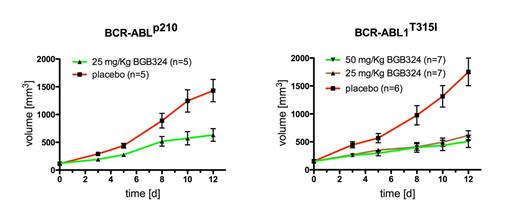Abstract
BCR-ABL1 inhibitors have revolutionized the treatment of CML patients. However several drawbacks remain, including clinical resistance of T315I-mutated CML. Further, the clinical success of ponatinib, a selective inhibitor of T315I-mutated BCR-ABL1 is hampered by vascular side effects. Therefore, novel treatment strategies are warranted especially in T315I-mutated CML.
We investigated the relevance of the Gas6-Axl axis in CML patients and the therapeutic potential of the clinically applicable small molecule Axl inhibitor BGB324 in primary CML (stem cell) samples, cell lines and preclinical models. We previously found that Gas6 and Axl represent potential novel targets in this disease and that BGB324 inhibits CML growth in vitro and in vivo (Erdmann et al., ASH meeting 2013, New Orleans, #1469).
We next wished to confirm Axl as specific therapeutic target and therefore down regulated its expression in KCL-22 and K562 cells by means of shRNA. In these experiments blockade of Axl inhibited CML cell proliferation in comparison to control-transduced cells, thereby confirming that Axl promotes CML growth. Subsequently, we added BGB324 to shAxl- and shcontrol-transduced cells. Surprisingly BGB324 inhibited cell growth significantly more in shAxl-transduced cells in comparison to control-treated shAxl-transduced cells (p<0.05). These experiments indicated that BGB324 was inhibiting an additional target which supported CML cell proliferation, besides Axl. In order to identify this target we carried out a Kinome Scan revealing that BGB324 binds to native and mutated ABL1. Interestingly, the affinity of BGB324 for ABL1 carrying different mutations including T315I was 5 to 50 fold higher compared to unmutated ABL1 (Table 1).
Next, we incubated BaF3 cells stably transfected with BCR-ABL1p210, BCR-ABL1T315I, BCR-ABL1M351T and BCR-ABL1E255K with various concentrations of BGB324 in order to determine its IC50 in the different cell lines. These experiments showed in concordance with the Kinome Scan that BGB324 was more potently inhibiting growth of mutated BCR-ABL1 compared to BCR-ABL1p210 (IC50 BCR-ABL1p210 1266 ± 126 nM; BCR-ABL1T315I 726 ± 194 nM; BCR-ABL1M351T 847 ± 10 nM and BCR-ABL1E255K 794 ± 39 nM; n=2-3; p<0.05 compared to BCR-ABL1p210).
Notably, further experiments revealed that BGB324 inhibited KCL-22 cells and K526 cells to a similar extent compared to the combination of imatinib (IM) and shAxl. Thus, BGB324 is a dual inhibitor of BCR-ABL1 and Axl.
As the inhibition of BCR-ABL1T315I is of special clinical interest we wished to confirm this finding further in vivo. Therefore we inoculated BCR-ABL1p210 and BCR-ABL1T315I cells subcutaneously into NSG mice. After the tumors reached a size of 80-100 mm3 mice were randomized to receive either placebo control or 50 mg/kg BGB324 delivered twice daily by oral gavage. This experiment showed potent inhibition of tumor growth after 12 days with higher activity of BGB324 in mice bearing BCR-ABL1T315I tumors (placebo: 1751 ± 606 mm3, BGB324: 614 ± 224 mm3; p=0.001) compared to mice bearing BCR-ABL1p210 tumors (placebo: 1432 ± 403 mm3; BGB324: 632 ± 229 mm3; p=0.05) (Figure 1).
Subsequently, tissue harvested at end-stage was subjected to immunohistochemical staining for the proliferation marker phospho-histone H3 and Western Blot analyses of cleaved caspase 3 in order to determine whether reduced proliferation and/or increased apoptosis was responsible for reduced growth of BCR-ABL1T315I tumors upon treatment with BGB324. These analyses revealed that proliferation as determined by histomorphometric analysis of phosho-histone H3 was reduced while cleaved caspase 3 levels were unchanged. These data were further corroborated by the finding that treatment with BGB324 reduced the level of phosphorylated MapK as determined by immunoblotting and densitometry. Thus, BGB324 inhibits proliferation of BCR-ABL1T315I cells in vivo.
Altogether, our findings show that BGB324 represents a dual inhibitor of Axl and ABL kinase with therapeutic potential in CML, in particular in BCR-ABL1T315I disease. As BGB324 was shown to be well tolerated in healthy volunteers (Wnuk-Lipinska et al., AACR meeting 2013 San Diego #1747), our findings pave the way for clinical investigation of BGB324 in (T315I-mutated) CML.
| Gene . | KinomeScan Kd (nM) . | KinaseProfiler IC50 (nM) . |
|---|---|---|
| Axl | 0.4 | 3 |
| ABL1 | 51.88 | 51 |
| ABL1(E255K) | 1.15 | n/a |
| ABL1(T315I) | 10.13 | 4 |
| ABL1(Y253F) | 18.19 | 26 |
| Gene . | KinomeScan Kd (nM) . | KinaseProfiler IC50 (nM) . |
|---|---|---|
| Axl | 0.4 | 3 |
| ABL1 | 51.88 | 51 |
| ABL1(E255K) | 1.15 | n/a |
| ABL1(T315I) | 10.13 | 4 |
| ABL1(Y253F) | 18.19 | 26 |
Loges:BerGenBio: Research Funding, travel support, advisory boards Other.
Author notes
Asterisk with author names denotes non-ASH members.



